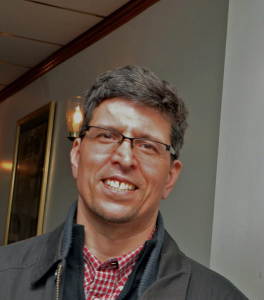Ron Cassie is a senior editor of Baltimore Magazine, a national award-winning journalist, and author of recently released If You Love Baltimore, It Will Love You Back. Here, Jessie Walker speaks with Cassie to learn more about his new book, writing process, and all things Baltimore.

Photo by Bill Hughes
There’s no denying that Baltimore Magazine’s Ron Cassie has an impressive journalism portfolio. He’s won national awards for his coverage of the death of Freddie Gray, sea-level rise on the Eastern Shore, and the opioid epidemic in Hagerstown. But this fall, Cassie has ventured into new writing territory by adding his own book of essays to the mix.
Published by Apprentice House, If You Love Baltimore, It Will Love You Back debuted in October. In his book, Cassie shares the kind of stories that will make prideful Baltimoreans nod knowingly and encourage outsiders to look at our city from a different angle. Jessie Walker spoke with Cassie to learn more about his new book, writing process, and all things Baltimore.
Tell us about your connection to Baltimore. Were you born and raised in the city or did you arrive here via another path?
I was born in North Jersey, but went to high school in Allentown, PA, and then moved to Baltimore in the mid-1980s. I don’t know how many people move to Baltimore for the adventure, but I did. Baltimore reminded me some of Allentown—blue collar, rowhouses, corner bars—but we didn’t have crabs, Memorial Stadium, the old WHFS, and City Paper in Allentown. I’d swung a hammer in Allentown and then eventually started tending bar here. There was more stuff to do here and new trouble to get into. Sometimes I joke Baltimore is my not my birthplace, but spiritual home. It’s true, though.
While you have a massive, award-winning portfolio for your work in journalism, If You Love Baltimore, It Will Love You Back is your first book. Talk about your inspiration for the book and what the publishing process has been like.
Every year, I do a couple long-form investigative pieces at Baltimore magazine where I serve as senior editor, and a few of those have won national awards, which is great. But yeah, I’m also extraordinarily curious about everyday people’s lives and journeys, especially the stories that fly beneath the radar. Celebrities or people who have achieved a certain level of status don’t interest me as much as a writer. I guess they often seemed guarded. But after a decade roaming around Baltimore with a notebook in my back pocket, I’d written up a bunch of these more intimate pieces. These snapshots. This inspiration for collecting them into a book, honestly, was I didn’t want to lose these stories. I’ve worked for two newspapers, a website, and another magazine that went out of business, and when that happens everything disappears with them.
Some might say that Baltimore can be a tough city to love. What makes you love the City of Baltimore despite its challenges?
I guess I love Baltimore because of its challenges. Those are the cracks where the light comes in, right? At least I love people’s response to the city’s challenges. Most of the time it’s love, it’s forgiveness. It’s compassion. The book is not pollyannish, but real and true stories as the title says. My experience in Baltimore has been that if you reach out in this city, someone will reach back and thank God for that because I’ve needed help myself over the years. It’s not that bad things don’t happen in this city, because they do, but people here will pick you up. We need each other here. That’s where the title comes from. The resilience of Baltimore folks is incredible.
The book includes encounters with well-known public figures like the late Rep. Elijah Cummings and former Senator Barbara Mikulski, but most of your stories focus on the everyday Baltimorean. Tell us about some of these more ‘unknown’ Baltimoreans in your book and why their stories resonated with you?
Where to begin? Mary Carol Reilly, the 77-year-old ex-nun-in-training turned actress, cabbie, Romper Room teacher, and Texas Hold ‘Em poker player? Chris Whitaker, who finds antique portrait photos in Hampden curio shops, and then traces them back and unites them with their descendant family members? Or Vander Pearson, who owns Pearson’s Florist at corner of North Charles and North Avenue, steadfastly staying put for 40-plus years while the whole world has changed around him several times. Or the ‘squeegee kids,’ who are way more fun and engaging to spend a couple of afternoons with than many people might think. Why do these people and stories resonate with me? I don’t know if I have a great answer for that. My short answer is I must be learning something I think is valuable from these folks and their stories or I wouldn’t be motivated in writing about them. I’m not a writer who really likes to write. It’s more of a necessity in terms of helping me process things and fortunately is my job. Generally, I assume that if I think if I find a story interesting, other people will too. Not everyone, but enough that it makes my small endeavor of writing worthwhile.
Can you tell us about any notable stories that didn’t make it into the book or were perhaps written after the book was already in the publishing process?
The stories in this collection are written in a real-time, present-tense style. So I was physically present in these pieces, most are vignettes, and then (trying) to give the reader the sense of being there in the middle of the action of whatever was taking place. In that way, they’re not like traditional journalism, investigative reported stories, or even full-length profiles, or pure history pieces, but more like photographs, which taken as whole, hopefully, provide an unusual look at the city. Also not included are the pieces that don’t take place in Baltimore, for example, stories I’ve done on sea level rise on the Eastern Shore and the opioid epidemic in Hagerstown.
2020 has been a wild year; how have you managed to stay inspired during the coronavirus pandemic?
That’s a good question. It’s been a challenge. I get inspired by moving about the city, mostly riding my bike everywhere, and meeting people, stumbling on odd stories. I did start anonymous social media writing project to cope, a purely hobby thing, that’s wrapping up soon and that I hope to turn into my next book. It’s set in Baltimore. But it’s just over one long summer in the 1970s.
Do you have any advice for writers who dream of publishing a book one day too?
Find a subject and create a project you love, do it as honestly and best you can. Imagine if you were self-publishing and ask yourself what’s the form look like that best suits the project? In writing, reviewing, and now publishing a book, the possibilities are endless. Once you’ve got it together, or mostly together, then look for a publisher.
Lastly, what are some of your go-to spots in the city when you are seeking inspiration?
That’s hard because for me, inspiration comes unexpectedly. So I’d say my go-to spot is my bicycle. And all our great bookstores. I lose myself riding my bike and also just picking up books and reading over some coffee. Time stops and ideas, I think, begin germinating—although they may not quite rise to the surface until much later. But my bike gets me moving about the city and inevitably something, often a number of things, will turn my head.
